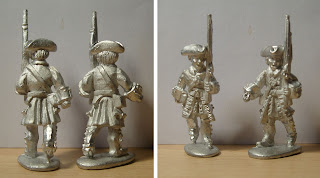Like many collectors, I want to obtain figures that look a little "different" Additionally, as recruiting funds are limited, I like to find items that are good value. When I chanced upon
Blaze Away Miniatures & Models early C18 range, my interest was piqued.
 |
| MAL2,3 & 5 with venerable Foundry "Marlburian" |
Marketed under the generic "Malborough's Wars" legend, on offer are 13 packs (7 Infantry, 5 Cavalry and 1 High Command) priced fairly competitively at AUD$10.00 / £6.40 - your money buys you 6 foot or 3 cavalry. Additionally, they offer a sample service for a very low sum - details at the site. All very well but are the little chaps any good? My opinion is a solid "Yes" - they are well worth a look.
I obtained three Infantry samples. All wear a tricorn and have hair hanging loose rather than the later "cue". The three poses I sampled are MAL2 Marching, MAL3 March Attack & MAL5 Advancing. These are shown, along with an old Foundry Marlburian, in the photo to the right .
As can be seen the figures stand 28mm foot to eye, though the thick bases make them appear a little taller. The level of detail is good and the anatomy is decent. Figures display heavy lacing on the coat front and cuffs. The coat itself is of "full" cut. They sport a small satchel on the right hip and carry muskets without bayonet. Supplied as a loose part is the sabre, ready for the buyer to attach to the left side of the model. I am aware some people will dislike this feature but I do not. Clearly it has been decided that it is prudent to cast the figures in two parts and thus eliminate a common miscasting area.
 |
| Earlier C18 in gaiters? Great! |
I am not particularly keen on "advancing" poses as I prefer my units to march for all eternity. However MAL5 is a perfectly acceptable miniature. I think he would be well suited to a skirmishing unit - perhaps in the Colonies? The marching poses are particularly attractive and can (in my opinion) be used mixed within the same unit. To my delight they are modeled in gaiters rather than the more usual stockings and breeches. The mixture of earlier C18 coat and gaiters makes these fellows pretty unusual in 28mm and ideal for my 1740 project.
 |
| The sabres ready for attachment. |
Criticism is limited, MAL2's right arm may be a little short and the heads a little large but the latter affliction is near universal in 28mm. That said, overall the figures look good. They have bland facial features and to me this is a plus (character figures look great once but in every Regiment? No thanks!) Well painted they would present a splendid appearance.
It should be noted that at present BAM do not offer any Grenadiers or Artillerists and I have no idea if they plan to rectify this. I imagine Dixons' gunners would work well in concert with these chaps. The cavalry options are limited but Dragoons & Cuirassiers are certainly there. As mentioned earlier, there is a pack of bewigged Generals that look interesting.
From the quality of the samples and shipping time (under 1 week from Australia - UK) I recommend anyone interested in these obtains some samples pronto.
Scores out of 10 - thoroughly personal ratings explained:
Sculpting - Quality of detail and accuracy
Casting - Mismoulds and flashing
Variety - How comprehensive is the range
Service - Was the seller easy to reach, polite and helpful
Delivery - How long did they take to get to me
Value - Are they a good deal overall
Delivery time based upon my experience - Australia to UK delivery.
Sculpting: 7/10
Casting: 9/10 A few pinholes but excellent overall.
Variety of Subject: 5/10 No Artillery or Grenadiers.
Customer Service: */10 Dealings automated, therefore no rating.
Delivery Time: 10/10 Less than a week from the other side of the World!
Value: 8/10













